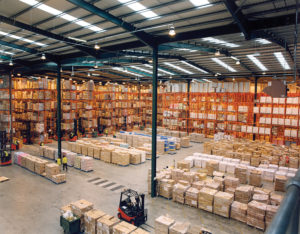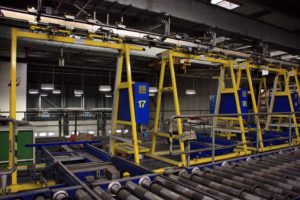Good data management is the cornerstone of most successful modern businesses. In the steel and metal fabrication, how you handle, process, and analyze data will impact every facet of your business, from the happiness of the employees who spend their days handling spreadsheets to the strength of your inventory management system.
Steel service centers and metal fabricators must be prepared to meet the ever-changing demands of this data-reliant digital world. So, if you’re falling behind, feeling like essential data is slipping through the net, or aren’t properly utilizing data, it’s time for an update.
Enhance Your Data Collection
When we say “data”, we’re not simply referring to client and supplier contact details. It applies to every aspect of your business, and the more data you collect, the more you can learn about how your business operates and where improvements can be made.
For example, RealSTEEL™ inventory management systems will track all of your incoming stock, showing you how much you have of certain materials and recording details such as dimensions, quantities, condition, and chemical attributes. Other ways to boost data collection across your business include:
Iot Sensors
The Internet of Things (IoT) refers to the interconnectivity of multiple devices. You can integrate sensors into your machinery, for instance, and then collect real-time data relating to the performance and condition of those machines. Those sensors will tell you how much a machine is being used, whether there are any issues, if it’s running optimally, and when it needs maintenance.
RFID Tags
As with IoT sensors, RFID tags can tell you specific details about business assets, including locations and stock levels. Attach RFID tags to these assets, read them using RFID sensors, and then feed the information into your computing system to help your employees with stock management and production.
Use Digital Twins
Digital twins are digital representations of physical machines. Manufacturers use them to test new configurations without changing the production cycle and dealing with the real-world implications.
Improve the Quality of Your Data
Not all data is useful, and as there will be a lot of it, you need to establish protocols to sort the wheat from the chaff. Create guidelines to establish which data is important and how that data is stored and used.
Check and validate the data to look for inaccuracies and inconsistencies, and conduct regular audits to make sure these systems are operational and data is properly utilized.
Take sales orders and invoicing as an example. You can use automated programs that rely on machine learning and AI to automatically read and process invoices. However, if you receive an irregularly formatted invoice, the system may struggle to properly input the data, leading to inaccurate or incomplete invoices. If you keep checking and validating those invoices, however, it will eventually learn how to deal with those documents.
Properly Analyze Your Data
Once you have gathered and validated the data, it’s time to analyze and look for improvements.
There are a few ways you can do this. The easiest is to use data visualization tools that will turn all of that complex data into clear and concise insights. You can then use statistical analysis to find issues, refine your production process, and perform a predictive analysis to optimize areas such as:
- Inventory Management: Data can tell you how much of a given material is needed right now and how much will be needed in the future. You can buy the materials you need when you need them, thus reducing waste and storage costs from overstocking and preventing delayed orders from understocking.
- Predictive Maintenance: The data gathered from IoT sensors will tell you how likely a machine is to malfunction and break down. By analyzing the data properly, you can perform proactive maintenance and prevent costly downtime.
- Consumer Trends: Analyzing customer and market data provides insights into consumer trends, allowing you to prepare your inventory and production accordingly.
Automate Simple Processes
Data is the driving force behind machine learning and AI technologies. The more data they process, the more they will understand about your business. These programs can then automate simple tasks, such as processing invoices, submitting orders, booking repairs and maintenance, and dealing with customer queries and returns.
Start by identifying the repetitive tasks that don’t properly utilize your workforce. Find automated solutions and create custom workflows to ensure these tasks are performed to the required standard.
It’s important to monitor all automated tasks, especially in the beginning. Although rare, mistakes can occur, and by spotting them, fixing them, and adjusting the workflow accordingly, you can prevent issues in the future and eventually leave AI to do all of the work.
Use RealSTEEL™ ERP Solutions
RealSTEEL™ is a state-of-the-art business management solution tailored for the steel and metals industry. It includes integrations designed to optimize every aspect of operations for metal fabricators and steel service centers, and offers benefits such as:
- Real-time inventory management: Track all of your inventory in real time using advanced and comprehensive reporting features and accounting for attributes such as dimensions, chemical composition, freight, surcharges, and more.
- Flexible accounting: Manage your company finances in one place, using integrated data and seamless financial tools. Find out where money is being spent and where changes are needed, and create specialized budgets and forecasts.
- All-in-one purchasing: Calculate costs automatically, purchase materials more effectively, and create fast and accurate sales orders.
- Production software: Plan and schedule production and gain insights into processes such as coil slitting, plate and sheet processing, and more. Our steel optimization software will reduce waste, speed up production, and improve your bottom line.
- Warehouse management: Support the daily operations of your warehouse team with integrated features that help you to maximize space, reduce wastage, and simplify bin setup.
To learn more about our software and the ways it can benefit your business, contact us and request a demo.




